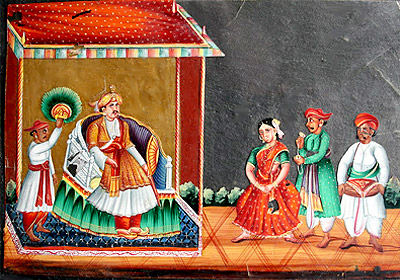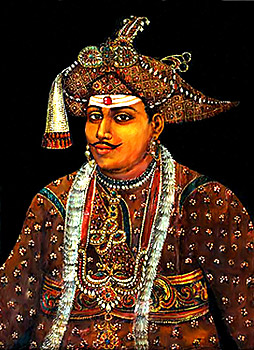 Venkoji was the founder of Thanjavur Maratha Kingdom. After the decline of the Chola rule Thanjavur was ruled by the Pandyas who ruled for about a century. Thanjavur was in a chaotic state. However it was conquered by the Vijayanagar Empire. The Nayaks of Madurai eventually conquered Thanjavur in 1646. The Thanjavur Nayaks rule lasted until 1673.
Venkoji was the founder of Thanjavur Maratha Kingdom. After the decline of the Chola rule Thanjavur was ruled by the Pandyas who ruled for about a century. Thanjavur was in a chaotic state. However it was conquered by the Vijayanagar Empire. The Nayaks of Madurai eventually conquered Thanjavur in 1646. The Thanjavur Nayaks rule lasted until 1673.
Chokkanatha had placed his brother Alagiri on the throne of Thanjavur, but within a year his brother went against him and Chokkanatha was forced to make Thanjavur independent. Vijaya Raghava`s son induced the Bijapur Sultan to help him get back the Thanjavur throne. The Sultan of Bijapur sent a force commanded by the Maratha general Venkoji to recapture the kingdom from the new invader in 1675. He defeated Alagiri and occupied Thanjavur. He seized the kingdom and made himself the king; this marked the rule of Marathas over Thanjavur.
Rulers of Thanjavur Maratha Kingdom
Venkoji
Venkoji was a half-brother of the great Maratha king Shivaji. He was the first Raja of Thanjavur from the Bhonsle dynasty. It is considered that he took over Thanjavur`s administration in April 1674 and ruler till 1684. Shivaji invaded Gingee and Thanjavur in 1676-1677 during his reign and made his brother Santaji the ruler of all lands that were to the north of the Coleroon. Venkoji allied with Chokkanatha of Madurai to ward off an invasion from Mysore.
Shahuji I
Venkoji was succeeded by his son Shahuji I who ascended the throne at the age of twelve. The Mughals occupied the Coromandel Coast and Tiruchirapalli and forced Shahuji I to pay tribute.
Serfoji I
Serfoji I was a younger son of Venkoji who ruled from 1712 to 1728. During his rule there was regular warfare and disputes with Nayaks of Madurai.
Tukkoji
Tukkoji was the younger brother of Serfoji I who ruled Thanjavur from 1728 to 1736. During his rule Chanda Sahib had invaded Thanjavur. He repulsed a Muhammedan invasion of Madurai.
Pratapsingh
After the death of Tukkoji a period of disorder followed and it came to an end when Pratapsingh succeeded in 1739. He ruled up to 1763. He was associated with Muhammad Ali, the Nawab of the Carnatic and aided the British against the French in the Carnatic Wars and the Seven Years War. In 1762, he became a vassal of the Nawab of the Carnatic after signing the tripartite treaty between Thanjavur, Carnatic and the British.
Thuljaji
He was a weak ruler and the last independent ruler of Thanjavur. Thanjavur was annexed by the Nawab of the Carnatic in 1773, who ruled till 1786. It was restored to him by the Directors of the British East India Company as a result of which he had to surrender his independence.
 Serfoji II
Serfoji II
Serfoji II succeeded Thuljaji in 1787. He was deposed by his uncle Amarsingh who seized the throne for himself. He recovered it with the help of the British in 1798. He ruled till 1832.
Shivaji II
Shivaji II was the last Maratha ruler of Thanjavur and ruled from 1832 to 1855. He was a weak prince. As he died childless in 1855, Thanjavur was taken over by the British.
Literature under Thanjavur Maratha kingdom
The Thanjavur Maratha favoured Sanskrit and Telugu languages. Most of the plays were composed in Sanskrit. Venkoji composed a `Dvipada` Ramayana in Telugu. His son Shahuji also patronised literature. Most of the works were composed during his rule. They are versions of the Ramayana or Historical plays. Advaita Kirtana is a well known composition that belongs to this period. Serfoji II built the Saraswathi Mahal Library. He was well versed in languages like English, French, Dutch, Greek and Latin other than some Indian languages.
Administration under Thanjavur Maratha kingdom
The king was assisted by a council of ministers. The supreme head was a Mantri or Dalavoy. He was also the Commander-in-chief of the Army. Pradhani or Dewan or Dabir Pandit alos occupied an important position. The kingdom was divided into subahs, seemais and maganams in the decreasing order of size and importance. Pattukkottai, Mayavaram, Kumbakonam, Mannargudi and Tiruvadi were the five subahs.
Economy under Thanjavur Maratha kingdom
Taxes were collected from the people through mirasdars or puttackdars. They were collected from the village level onwards and were based on the agricultural output of the village. Rice was a major cultivated crop of the region and the land used for cultivation was owned by big landlords. Foreign trade was not carried out. Only European traders were engaged in foreign trade who paid a particular amount of money as rent to the King. The currency system was that of a chakram or pon. Other systems of coinage included pagoda, a big panam and a small `panam.






































